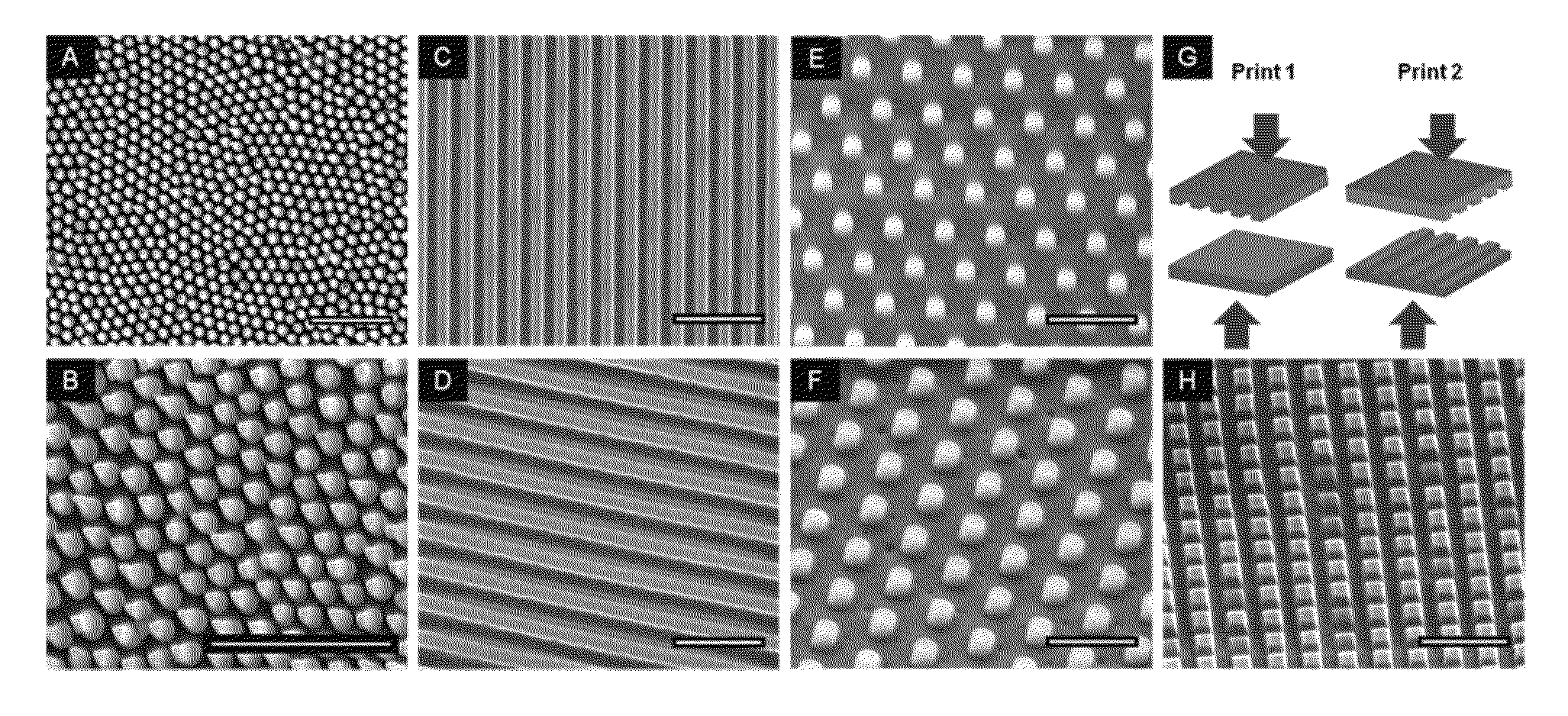Bactericidal surface patterns
a surface pattern and bacteria technology, applied in the field of surface textures, can solve the problems of reducing the useful life of biomedical implants, releasing harmful toxins in the body, and neither long-term solutions can be found
- Summary
- Abstract
- Description
- Claims
- Application Information
AI Technical Summary
Benefits of technology
Problems solved by technology
Method used
Image
Examples
example 1
[0045]Cellular interactions with biomedical materials are critical to the performance of medical devices. Biofilm build-up is one major cause of failure for prosthetic implants. Researchers have modified the surface chemistry of biomaterials with biocide-releasing or anti-adhesion coatings, but these are not long-term solutions. There has been increasing interest in designing nanostructured surfaces inspired by nature. The inventors designed nanoscale pillar structures which have the ability to kill bacterial cells purely through physical surface topography. The inventors developed methods that can prevent biofilm buildup through physical surface modifications.
[0046]Nano structures were created on polymethylmethacrylate (PMMA) films using nanoimprint lithography, which involves pressing a silicon mold onto a polymer film at high temperatures above Tg. Softening of polymer films was accomplished by using heated or plasticized films, or by heating the molds. The pillars in this exampl...
example 2
Length Measurements of Bacteria
[0049]The length and diameter of bacterial cells in randomly chosen regions in the micrographs were measured to determine cell aspect ratios on the flat control and the nanopatterned surfaces. The nanopatterned surfaces used for these experiments were line gratings L1, the smaller spaced lines, and round pillars P1, the smaller spaced pillars. The cell aspect ratio was calculated as the ratio of the length over the diameter of the bacterial cells. The average aspect ratio of bacterial cells on the flat PMMA control, line gratings L1 and round pillars P1 were determined across three trials. The average aspect ratios of the live and dead bacterial cells on the flat PMMA control across three trials were 2.34 and 3.41, respectively. The average aspect ratios of the live and dead bacterial cells on line gratings L1 across three trials were 2.02 and 3.42, respectively. The average aspect ratios of the live and dead bacterial cells on the round pillared PMMA ...
example 3
Overview
[0051]One cause of failure of implantable medical devices is infection caused by bacteria that adhere to the surface of the implant. Since chemical modifications of the material surface are not long-term solutions in preventing bacterial adhesion, several groups employ physical surface topography made by common microfabrication methods. However, these fabrication methods cannot control the dimensions of very fine-features, especially at the nanoscale. Using nanoimprint lithography, they fabricated nanoscale structures, including line gratings and pillars, on the surface of poly(methyl methacrylate) (PMMA) films. Upon seeding Escherichia coli on the imprinted PMMA structures, they observed decreased bacterial adhesion and an increase in the percentage of dead cells on the nanopillar structures compared to flat unpatterned surfaces and line gratings. They also observed that the spacing of the features, especially for the pillars, affected the degree of adhesion and increased c...
PUM
| Property | Measurement | Unit |
|---|---|---|
| diameter | aaaaa | aaaaa |
| diameter | aaaaa | aaaaa |
| diameter | aaaaa | aaaaa |
Abstract
Description
Claims
Application Information
 Login to View More
Login to View More - R&D
- Intellectual Property
- Life Sciences
- Materials
- Tech Scout
- Unparalleled Data Quality
- Higher Quality Content
- 60% Fewer Hallucinations
Browse by: Latest US Patents, China's latest patents, Technical Efficacy Thesaurus, Application Domain, Technology Topic, Popular Technical Reports.
© 2025 PatSnap. All rights reserved.Legal|Privacy policy|Modern Slavery Act Transparency Statement|Sitemap|About US| Contact US: help@patsnap.com



